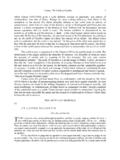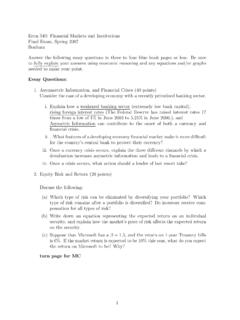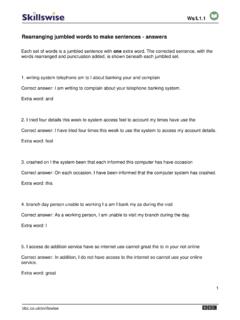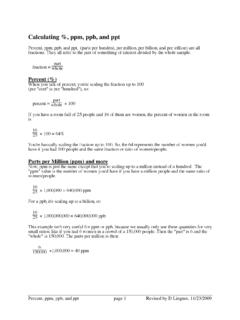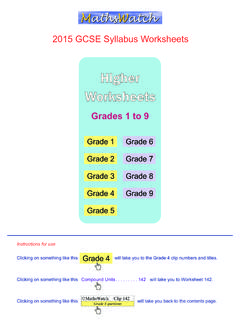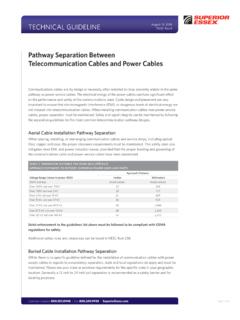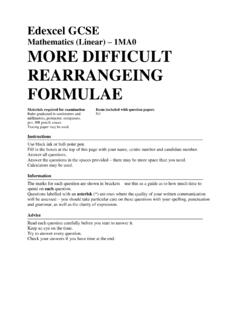Transcription of State Variable Modeling - University of Hawaii System
1 Chapter 2 State Variable ModelingThe purpose of this session is to introduce the basics of State Variable Modeling known as statespace techniques. The State space technique is a unified time-domain formulation that can beutilized for the analysis and design of many types of systems. It can be applied to linear andnonlinear continuous-time and discrete-time multivariable Pre-Lab AssignmentAn introduction to the basics of State Variable Modeling can be found in Appendix B. Read theAppendix and familiarize yourself with State Variable creation as well as the analytical and numericalmethods of Laboratory ProcedureComplete the following case study after reading Appendix :Third-order low-pass circuit shown in Figure is a third-order Butterworth filter. Select appropriate statevariables and obtain the State and output equations. Treat the output, ( ), as the voltageacross the general idea is to express the differential equations that describe the circuit as a systemin matrix form.
2 With this in mind, the following notes may be helpful: In the absence of all capacitor and voltage source loops and all inductor and currentsource cut-sets, the number of State variables is equal to the number of energy 2. State Variable Modeling Appropriate State variables may be the voltage across the capacitor and the current inthe inductors. Write a node voltage equation for every node touching a capacitor. Also, consider writingloop equations in terms of the inductor currents for loops containing a script m-file and use the Control System Toolbox functionsssandltiviewto formthe State model and its step response. Also, usess2tfto obtain the filter s transfer the m-file. Right-click on the LTI Viewer and use Characteristics to display all of thetime-domain specifications. Be sure to look at both the step- and impulse-response on the LTI Viewer again and from the Plot Type list, select Bode.
3 From theFile menu, select Print to Figure to obtain a figure plot capable of being edited. Click onthe magnitude response and hold and drag to display the corner frequency at -3 dB. Nowdrag to display the attenuation at 10 the step response characteristics and the filter transfer function. Comment on thefilter frequency response Take-Home AssignmentExperiment and Experiment in Cyber Exploration Laboratory at the end of Chapter 3 ofControl Systems Engineering by Nise, 6th BBasics of State Space Introductory ConceptsThe differential equations of a lumped linear network can be written in the form ( ) = ( ) + ( )( ) ( ) = ( ) + ( )( )Equation ( ) is a System of first-order differential equations and is known as thestateequationof the System . The vector ( ) is thestate vector, and ( ) is theinput vector. Equation ( ) isreferred to as theoutputequation.
4 Is called the State matrix, the input matrix, the outputmatrix, and is the direct transition advantage of the State space method is that the form lends itself easily to the digital andanalog computation methods of solution. Further, the State space method can be easily extendedto the analysis of nonlinear equations may be obtained from an order differential equation or directly from thesystem model by identifying appropriate State variables. To illustrate the first method, consider an order linear plant model described by the differential equation + 1 1 1+ + 1 + 0 = ( )( )Where ( ) is the plant output and ( ) is the plant input. A State model for this System is notunique but depends on the choice of a set of State variables. A useful set of State variables, referredto asphasevariables, is defined as: 1= , 2= , 3= , .. , = 1 1( )Taking derivatives of the first 1 State variables, we have 1= 2, 2= 3.
5 , 1= ( )In addition, comes from rearranging Eq. ( ) and substituting from Eq. ( ): = 0 1 1 2 1 + ( )( )5960 APPENDIX B. BASICS OF State SPACE MODELINGIn matrix form, this looks like 1 1 = 010 0001 1 0 1 2 1 1 1 + ( )( )Thus the output equation is simply = 1 0 0 0 ( )Example the State equation in phase Variable form for the following differentialequation:2 3 3+ 4 2 2+ 6 + 8 = 10 ( )Solution:The differential equation is third order, and thus there are three State variables: 1= , 2= , and 3= . The first derivatives are: 1= 2 2= 3 3= 4 1 3 2 2 3+ 5 ( )Or, in matrix form: 1 2 3 = 0 1 00 0 1 4 3 2 1 2 3 + 005 ( ) = 1 0 0 1 2 3 The developed to convert an order ordinary differential equation tothe State space phase Variable form.
6 The syntax is[A, B, C] = ode2phv(ai,k), and returns thetypical three matrices. The inputaiis a row vector containing the coefficients of the equation indescending order, andkis the coefficient on the right hand side. Using the ODE from , we would enter:Example Code:>> ai = [2 4 6 8];>> k = 10;>> [A, B, C] = ode2phv(ai,k)A =0 1 00 0 1-4 -3 -2B = INTRODUCTORY CONCEPTS6105C =1 0 0>>Equations of Electrical NetworksThe State variables are directly related to the energy storage elements of a System . It wouldseem, therefore, that the number of independent initial conditions is equal to the number of energystoring elements. This is true provided that there is no loop containing only capacitors and voltagesources, and there is no cut set containing only inductive and current sources. In general, if thereare loops of all capacitors and voltages sources, and cut sets of all inductors and currentsources, the number of State variables is = + ( )where and are the numbers of inductors and capacitors, :Circuit of Example B.
7 BASICS OF State SPACE MODELINGE xample the State equation for the network shown in Figure :Define the State variables as current through the inductor and voltage across thecapacitors. Write two node equations containing capacitors and a loop equationcontaining the inductor. The State variables will be 1, 2, and .Node 1 + + 1 4= 0 1= 1 4 + 2 + 2 = 0 2= 2 + 2 2+ 2 Loop equation:2 + 2 1= 0 = 1 2 Equivalently, in matrix form: 1 2 = 10 40 2 0 1 2 + 1 00 20 0 Simulation DiagramsEquations ( ) and ( ) indicate that State variables are determined by integrating the corre-sponding State equation. A diagram known as thesimulationdiagram can be constructed to modelthe given differential equations. The basic element of the simulation diagram is the integrator. Thefirst equation in ( ) is 1= 2.
8 Integrating we have: 1=Z 2 The above integral is represented by the time-domain block diagram shown in Figure andby the signal flow graph in Figure (a) Block diagram(b) Signal flow graphFigure :Simulation diagrams: Graphical representations of State integrators in the time is important to know that that although the symbol1 is used for integration, the simulationdiagram is still a time-domain representation. The number of integrators is equal to the numberof State variables. For example, for the State equation in Example we have three integratorsin cascade, the three State variables are assigned to the output of each integrator as shown inFigure The final State equation seen in ( ) is represented via a summing point andfeedback paths. Completing the output equation, we obtain the simulation diagram known asphase-variablecontrolcanonicalform (See Fig.)
9 INTRODUCTORY CONCEPTS63(a) Block diagram(b) Signal flowFigure :Simulation diagrams for Example in phase- Variable control canonical Transfer Function to State Space ConversionConsider the transfer function of a third-order System where the numerator degree is lower thanthat of the denominator. ( ) ( )= 2 2+ 1 + 0 3+ 2 2+ 1 + 0( )The above transfer function is decomposed into two (frequency domain) blocks in Figure :The transfer function of Eq. ( ) arranged in cascade formDenoting the output of the first block as ( ), we have the following input/output relationships: ( ) = ( ) 3+ 2 2+ 1 + 0( ) ( ) = 2 2 ( ) + 1 ( ) + 0 ( )( )Rearranging Eq. ( ), we get 3 ( ) = 2 2 ( ) 1 ( ) 0 ( ) + ( )( )Using properties of frequency-domain tranforms, we see that Equations ( ) and ( ) are thefrequency-domain representations of the following time-domain differential equations.
10 = 2 1 0 + ( )( ) ( ) = 2 + 1 + 0 ( )From the above expressions, we see has to go through three integrators to get (as shownin Figure ). Completing the above equations results in the phase- Variable control canonicalsimulation is a block diagram suitable for Simulink analysis. You may find it easier to constructthe simulation diagram similar to the signal flow graph as shown in Figure order to write the State equation, the State variables 1( ), 2( ), and 3( ) are assigned tothe output of each integrator from right to left in Figs. and Next, an equation is writtenfor the input of each integrator: 1= 2 2= 3 3= 0 1 1 2 2 3+ ( )64 APPENDIX B. BASICS OF State SPACE MODELINGF igure :Phase Variable control canonical simulation block diagram for the transfer function in Eq. ( )Figure :Phase Variable control canonical signal flow diagram for the transfer function in Eq.
